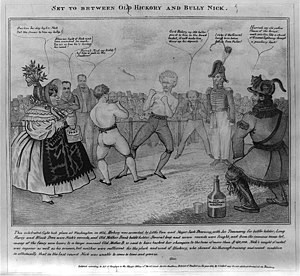| Bank War | |||
|---|---|---|---|
 Cartoon depicting the political conflict between Andrew Jackson and Nicholas Biddle over the Second Bank of the United States | |||
| Date | 1832–1836[1] | ||
| Resulted in | Anti-Bank Victory
| ||
| Parties | |||
| |||
| Lead figures | |||
| ||
|---|---|---|
|
Military career
7th President of the United States
First term
Second term
Post-presidency
Legacy
 |
||
The Bank War was a political struggle that developed over the issue of rechartering the Second Bank of the United States (B.U.S.) during the presidency of Andrew Jackson (1829–1837). The affair resulted in the shutdown of the Bank and its replacement by state banks.
The Second Bank of the United States was established as a private organization with a 20-year charter, having the exclusive right to conduct banking on a national scale. The goal behind the B.U.S. was to stabilize the American economy by establishing a uniform currency and strengthening the federal government. Supporters of the Bank regarded it as a stabilizing force in the economy due to its ability to smooth out variations in prices and trade, extend credit, supply the nation with a sound and uniform currency, provide fiscal services for the treasury department, facilitate long-distance trade, and prevent inflation by regulating the lending practices of state banks.[2] Jacksonian Democrats cited instances of corruption and alleged that the B.U.S. favored merchants and speculators at the expense of farmers and artisans, appropriated public money for risky private investments and interference in politics, and conferred economic privileges on a small group of stockholders and financial elites, thereby violating the principle of equal opportunity. Some found the Bank's public–private organization to be unconstitutional, and argued that the institution's charter violated state sovereignty. To them, the Bank symbolized corruption while threatening liberty.
In early 1832, the president of the B.U.S., Nicholas Biddle, in alliance with the National Republicans under Senators Henry Clay (Kentucky) and Daniel Webster (Massachusetts), submitted an application for a renewal of the Bank's twenty-year charter four years before the charter was set to expire, intending to pressure Jackson into making a decision prior to the 1832 presidential election, in which Jackson would face Clay. When Congress voted to reauthorize the Bank, Jackson vetoed the bill. His veto message was a polemical declaration of the social philosophy of the Jacksonian movement that pitted "the planters, the farmers, the mechanic and the laborer" against the "monied interest", benefiting the wealthy at the expense of the common people.[3] The B.U.S. became the central issue that divided the Jacksonians from the National Republicans. Although the Bank provided significant financial assistance to Clay and pro-B.U.S. newspaper editors, Jackson secured an overwhelming election victory.
Fearing economic reprisals from Biddle, Jackson swiftly removed the Bank's federal deposits. In 1833, he arranged to distribute the funds to dozens of state banks. The new Whig Party emerged in opposition to his perceived abuse of executive power, officially censuring Jackson in the Senate. In an effort to promote sympathy for the institution's survival, Biddle retaliated by contracting Bank credit, inducing a mild financial downturn. A reaction set in throughout America's financial and business centers against Biddle's maneuvers, compelling the Bank to reverse its tight money policies, but its chances of being rechartered were all but finished. The economy did well during Jackson's time as president, but his economic policies, including his war against the Bank, are sometimes blamed for contributing to the Panic of 1837.
- ^ Hammond 1947, p. 155.
- ^ Campbell 2019, pp. 3–4.
- ^ Hofstadter 1948, p. 57.

